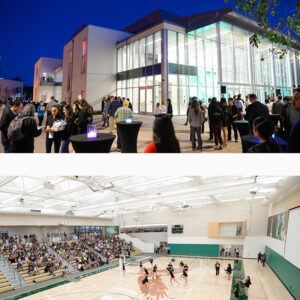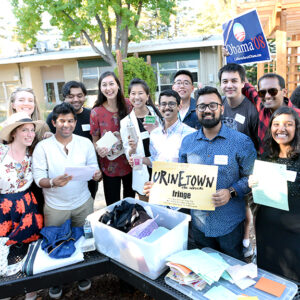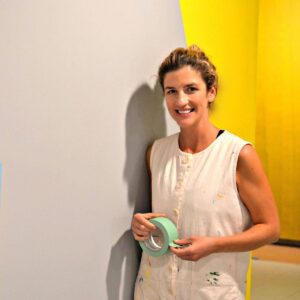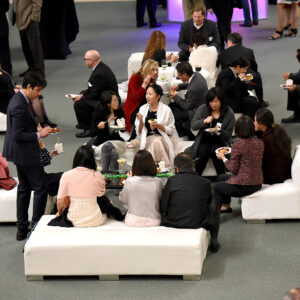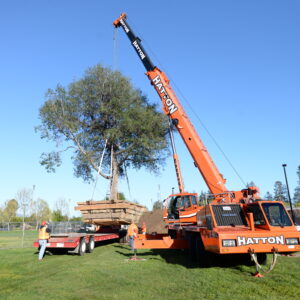This article originally appeared in the spring 2010 Harker Quarterly.
“If you build it…” The oft-quoted line from the movie “Field of Dreams” has been echoing in the halls of The Harker School the last few years. Nichols Hall, which opened to great celebration in the fall of 2008, has proven to be a spectacular home for science classes, competitive research students, music concerts and lecture series. Davis Field and the Singh Aquatic Center have taken the sports department to new levels of athletic achievement. And the buzz continues. Next on the plan: a performing and visual arts center (PVAC).
Harker’s six-phase capital improvements plan is currently completing phase 3, which was the building of the two new sports venues and Nichols Hall. (Previous phases improved the Bucknall campus and built Shah Hall.) Phase 4 is the long-anticipated PVAC, which will transform the 16-acre Saratoga campus yet again.
The groundwork for this next phase began in the fall of 2008 with a series of Head of School Gatherings, casual socials at the homes of Harker parents. At those events, Chris Nikoloff led discussions with interested parents about the future of the school, not only sharing information but gathering feedback about what parents wanted most for their campuses.
In 2009 focus groups were convened to discuss the master site plan in more detail, focusing on the gym and student union (phases 5 and 6). A third focus group narrowed the view on the PVAC. Families, students, alumni, faculty and administrators were invited to complete an online survey, which asked for very detailed opinions about the current performing arts and visual arts facilities, as well as the respondents’ wishes for the future. This information was crucial to the administration and architectural team, and “uncovered all sorts of valuable ideas and highlighted several issues that [David Takamoto, our architect,] has been able to address so that once completed everything works very well from parking, to campus flow to beauty,” said Joe Rosenthal, executive director of advancement, of the survey.
Head of School Gatherings continued in the fall of 2009, when Nikoloff presented parents with a draft of the master site plan, incorporating all the ideas culled from families, alumni and employees from the past year. The next step will be spearheaded by former head of school and current trustee Diana Nichols, who will host a series of meetings in the spring of 2010 to get further input on the developing project and unveil the conceptual design of the master site plan.
All of these gatherings and drawings are leading up to the submission by Takamoto of a conceptual design to the San Jose City Planning Commission. Currently Harker is zoned for residential occupancy; the administration wants to convert that zoning to planned development use, which would maximize the use of buildings on campus and greatly minimize the red tape involved as permits are sought for each new building. Another major benefit of the rezoning is that campus buildings will be permitted to reach 50 feet instead of the current 35, allowing for three-story buildings and a theater with room to install a fly system for moving props and scenery vertically on and off stage.
Other designated areas within the building will include a third floor dedicated to visual arts, allowing for natural lighting and separate rooms for stone carving, painting and ceramics; two theaters – a black box and a full-size space with orchestra pit; costume, prop and set building spaces; music and art classrooms and libraries; practice rooms; gallery space; and dressing rooms and lounge areas.
The visual and performing art staff is understandably excited about the project. Laura Lang-Ree, K-Gr. 12 performing arts chair, points out that, “We are the only high school in a 40-mile radius that does not have a theater. Our lack of facilities is dramatic when contrasted with the level of education we provide and the sheer interest in the program and volume of children that we educate. Both students and teachers deal with this subpar facility issue daily.”
Visual arts chair Jaap Bongers concurs: “Our current space does not allow our students to develop their artistic talents to their fullest extent, partly because they can’t spread out and are working in storage and drying areas. The new building will give us separate spaces for storing completed works, works in progress and active studio space. And a separate gallery will mean we can adequately highlight student and faculty art.
” Mike Bassoni, Harker’s facility manager, who has overseen each of the large construction efforts on all of Harker’s campuses, speaks for many families and teachers who are eager for a space that can match the talents of our students: “The new center will greatly enhance an already well-recognized Harker program. With new, state-of-the- art facilities, the possibilities only become that much greater. We know our programs are great, but a contemporary facility will serve as a picture frame to display that level of perfection for many, many people in the community to enjoy.” Rosenthal wants parents of all grades to “ensure that the legacy of excellence passes to the next generation of Harker students,” and that we “invest in programs that make a difference in the world.”
A small group of parents and faculty are already contributing to the $30-35 million that will be needed to build the PVAC. The architectural and rezoning fees are being paid for by the very generous contributions of a group of current and alumni parents whom Rosenthal calls “seed investors.” These kind donors will be recognized and thanked at this year’s Head of School Reception on April 30.
So will they come “if you build it?” Perhaps a project of this size needs a better tagline than one from a Hollywood film. Virginia Woolf once said that all that women needed to write fiction was money and a room of their own. Artists, too, need financial support and their own space to play, create, dream and exhibit. That space will be coming soon for all to enjoy!







